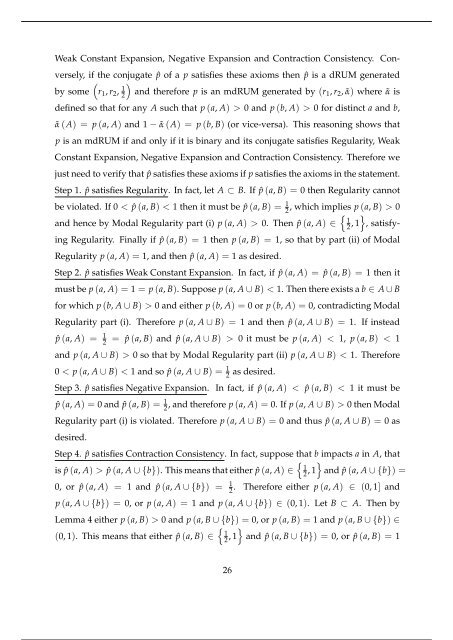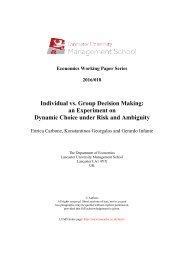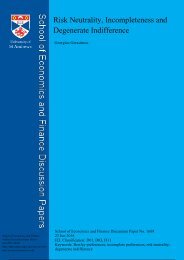Dual Random Utility Maximisation
n?u=RePEc:san:wpecon:1605&r=upt
n?u=RePEc:san:wpecon:1605&r=upt
Create successful ePaper yourself
Turn your PDF publications into a flip-book with our unique Google optimized e-Paper software.
Weak Constant Expansion, Negative Expansion and Contraction Consistency. Conversely,<br />
if the conjugate ˆp of a p satisfies these axioms then ˆp is a dRUM generated<br />
( )<br />
by some r 1 , r 2 ,<br />
2<br />
1 and therefore p is an mdRUM generated by (r 1 , r 2 , ˜α) where ˜α is<br />
defined so that for any A such that p (a, A) > 0 and p (b, A) > 0 for distinct a and b,<br />
˜α (A) = p (a, A) and 1 − ˜α (A) = p (b, B) (or vice-versa). This reasoning shows that<br />
p is an mdRUM if and only if it is binary and its conjugate satisfies Regularity, Weak<br />
Constant Expansion, Negative Expansion and Contraction Consistency. Therefore we<br />
just need to verify that ˆp satisfies these axioms if p satisfies the axioms in the statement.<br />
Step 1. ˆp satisfies Regularity. In fact, let A ⊂ B. If ˆp (a, B) = 0 then Regularity cannot<br />
be violated. If 0 < ˆp (a, B) < 1 then it must be ˆp (a, B) =<br />
2 1 , which implies p (a, B) > 0<br />
{<br />
and hence by Modal Regularity part (i) p (a, A) > 0. Then ˆp (a, A) ∈ 12<br />
, 1}<br />
, satisfying<br />
Regularity. Finally if ˆp (a, B) = 1 then p (a, B) = 1, so that by part (ii) of Modal<br />
Regularity p (a, A) = 1, and then ˆp (a, A) = 1 as desired.<br />
Step 2. ˆp satisfies Weak Constant Expansion. In fact, if ˆp (a, A) = ˆp (a, B) = 1 then it<br />
must be p (a, A) = 1 = p (a, B). Suppose p (a, A ∪ B) < 1. Then there exists a b ∈ A ∪ B<br />
for which p (b, A ∪ B) > 0 and either p (b, A) = 0 or p (b, A) = 0, contradicting Modal<br />
Regularity part (i). Therefore p (a, A ∪ B) = 1 and then ˆp (a, A ∪ B) = 1. If instead<br />
ˆp (a, A) = 1 2<br />
= ˆp (a, B) and ˆp (a, A ∪ B) > 0 it must be p (a, A) < 1, p (a, B) < 1<br />
and p (a, A ∪ B) > 0 so that by Modal Regularity part (ii) p (a, A ∪ B) < 1. Therefore<br />
0 < p (a, A ∪ B) < 1 and so ˆp (a, A ∪ B) = 1 2<br />
as desired.<br />
Step 3. ˆp satisfies Negative Expansion. In fact, if ˆp (a, A) < ˆp (a, B) < 1 it must be<br />
ˆp (a, A) = 0 and ˆp (a, B) =<br />
2 1 , and therefore p (a, A) = 0. If p (a, A ∪ B) > 0 then Modal<br />
Regularity part (i) is violated. Therefore p (a, A ∪ B) = 0 and thus ˆp (a, A ∪ B) = 0 as<br />
desired.<br />
Step 4. ˆp satisfies Contraction Consistency. In fact, suppose that b impacts a in A, that<br />
{ }<br />
is ˆp (a, A) > ˆp (a, A ∪ {b}). This means that either ˆp (a, A) ∈ 12<br />
, 1 and ˆp (a, A ∪ {b}) =<br />
0, or ˆp (a, A) = 1 and ˆp (a, A ∪ {b}) =<br />
2 1 . Therefore either p (a, A) ∈ (0, 1] and<br />
p (a, A ∪ {b}) = 0, or p (a, A) = 1 and p (a, A ∪ {b}) ∈ (0, 1). Let B ⊂ A. Then by<br />
Lemma 4 either p (a, B) > 0 and p (a, B ∪ {b}) = 0, or p (a, B) = 1 and p (a, B ∪ {b}) ∈<br />
{<br />
(0, 1). This means that either ˆp (a, B) ∈ 12<br />
, 1}<br />
and ˆp (a, B ∪ {b}) = 0, or ˆp (a, B) = 1<br />
26






